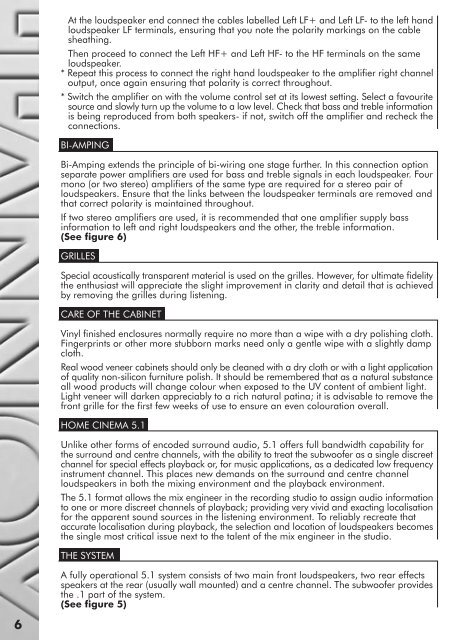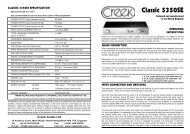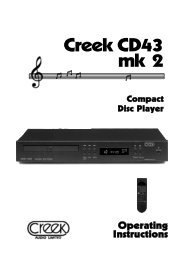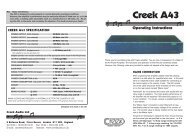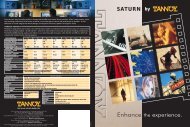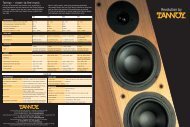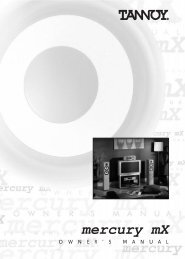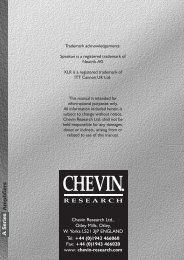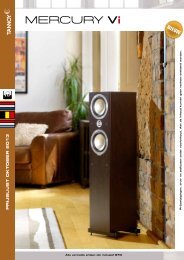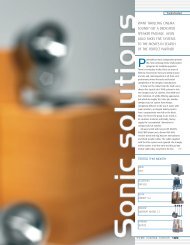Revolution by
Revolution by
Revolution by
You also want an ePaper? Increase the reach of your titles
YUMPU automatically turns print PDFs into web optimized ePapers that Google loves.
At the loudspeaker end connect the cables labelled Left LF+ and Left LF- to the left hand<br />
loudspeaker LF terminals, ensuring that you note the polarity markings on the cable<br />
sheathing.<br />
Then proceed to connect the Left HF+ and Left HF- to the HF terminals on the same<br />
loudspeaker.<br />
* Repeat this process to connect the right hand loudspeaker to the amplifier right channel<br />
output, once again ensuring that polarity is correct throughout.<br />
* Switch the amplifier on with the volume control set at its lowest setting. Select a favourite<br />
source and slowly turn up the volume to a low level. Check that bass and treble information<br />
is being reproduced from both speakers- if not, switch off the amplifier and recheck the<br />
connections.<br />
BI-AMPING<br />
Bi-Amping extends the principle of bi-wiring one stage further. In this connection option<br />
separate power amplifiers are used for bass and treble signals in each loudspeaker. Four<br />
mono (or two stereo) amplifiers of the same type are required for a stereo pair of<br />
loudspeakers. Ensure that the links between the loudspeaker terminals are removed and<br />
that correct polarity is maintained throughout.<br />
If two stereo amplifiers are used, it is recommended that one amplifier supply bass<br />
information to left and right loudspeakers and the other, the treble information.<br />
(See figure 6)<br />
GRILLES<br />
Special acoustically transparent material is used on the grilles. However, for ultimate fidelity<br />
the enthusiast will appreciate the slight improvement in clarity and detail that is achieved<br />
<strong>by</strong> removing the grilles during listening.<br />
CARE OF THE CABINET<br />
Vinyl finished enclosures normally require no more than a wipe with a dry polishing cloth.<br />
Fingerprints or other more stubborn marks need only a gentle wipe with a slightly damp<br />
cloth.<br />
Real wood veneer cabinets should only be cleaned with a dry cloth or with a light application<br />
of quality non-silicon furniture polish. It should be remembered that as a natural substance<br />
all wood products will change colour when exposed to the UV content of ambient light.<br />
Light veneer will darken appreciably to a rich natural patina; it is advisable to remove the<br />
front grille for the first few weeks of use to ensure an even colouration overall.<br />
HOME CINEMA 5.1<br />
Unlike other forms of encoded surround audio, 5.1 offers full bandwidth capability for<br />
the surround and centre channels, with the ability to treat the subwoofer as a single discreet<br />
channel for special effects playback or, for music applications, as a dedicated low frequency<br />
instrument channel. This places new demands on the surround and centre channel<br />
loudspeakers in both the mixing environment and the playback environment.<br />
The 5.1 format allows the mix engineer in the recording studio to assign audio information<br />
to one or more discreet channels of playback; providing very vivid and exacting localisation<br />
for the apparent sound sources in the listening environment. To reliably recreate that<br />
accurate localisation during playback, the selection and location of loudspeakers becomes<br />
the single most critical issue next to the talent of the mix engineer in the studio.<br />
THE SYSTEM<br />
6<br />
A fully operational 5.1 system consists of two main front loudspeakers, two rear effects<br />
speakers at the rear (usually wall mounted) and a centre channel. The subwoofer provides<br />
the .1 part of the system.<br />
(See figure 5)


